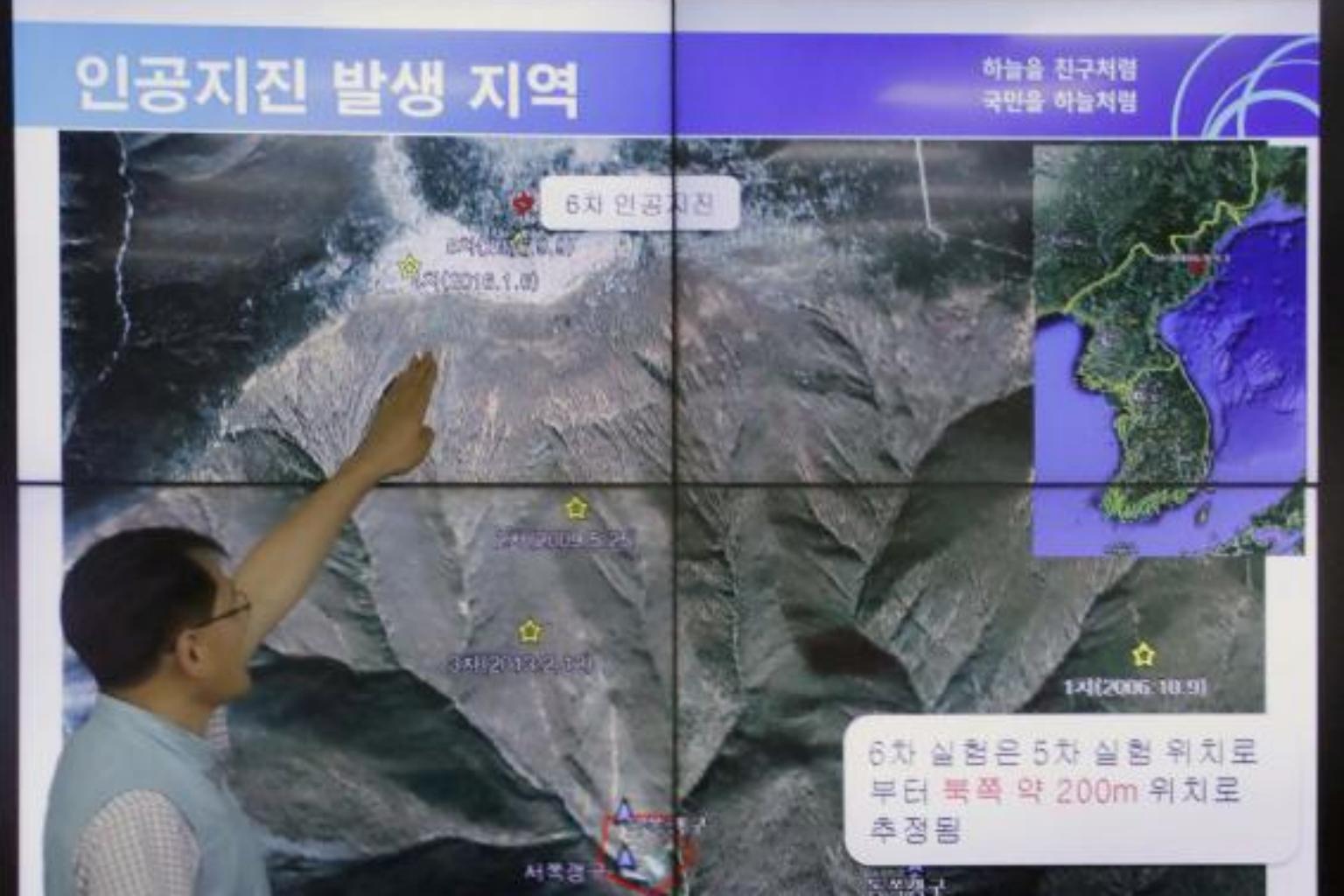Punggye-ri, North Korea's mysterious nuclear testing site
Sign up now: Get insights on Asia's fast-moving developments

Korea Meteorological Administration official Yoo Yong Kyu pointing out the location of an artificial earthquake that was detected at Punggye-ri on Sept 3, 2017.
PHOTO: EPA-EFE/YONHAP
Follow topic:
SEOUL - Situated in mountainous terrain in the north-east of North Korea, the Punggye-ri test site has witnessed six nuclear tests since 2006.
It is thought to be the country's main nuclear facility and the only active nuclear testing site in the world.
North Korean leader Kim Jong Un has announced plans to close the test site in May amid a thaw in chilly relations with South Korea and the United States. But scientists say the site has already partially collapsed and may be unusable, reported the BBC.
Here's what we know about Punggye-ri:
1. TUNNEL SYSTEM
Most of the information about the test site has been gleaned from satellite imagery and tracking the movement of equipment at the location.
Nuclear tests have been conducted in a system of tunnels dug below Mount Mantap, close to the site.
The first test was carried out on Oct 9, 2006, followed by a second one on May 25, 2009. Additional tests were conducted on Feb 12, 2013, and Jan 6 and Sept 9 in 2016. The sixth and most recent was carried out on Sept 3, 2017.
The excavation of tunnels is studied closely by North Korea watchers to discern whether the country is readying for a nuclear test.
Prior to its most recent nuclear test, analysts had noted that the site was in a standby state - based on satellite imagery - indicating readiness for a test.
Tunnelling and excavation work had been detected earlier in the year, with unidentified equipment placed outside one of the tunnels.
The test devices are buried at the end of the tunnels, which terminate in a hook shape. The tunnels are backfilled to prevent radiation leakage when detonation takes place.
US-based North Korean analysis website 38 North reported last month that satellite imagery indicated a significant slowing in tunnelling and other operations, which it attributed to the thaw in relations between Pyongyang and Seoul and Washington, South Korean news agency Yonhap reported.
2. ALLEGED COLLAPSE
Eight-and-a-half minutes after the test in September, scientists said there was a "near vertical on-site collapse towards the nuclear test centre.
The US Geological Survey recorded a second seismic event around eight minutes after the test, which was assessed as a collapse of the cavity.
In late December, two aftershocks were detected, raising concerns about the stability of the surrounding mountains.
A Japanese new outlet reported in October last year that a tunnel under construction at the site collapsed and as many as 200 workers could have been killed.
Mount Mantap may have "tired mountain syndrome," experts suggested, a phrase that was applied to Soviet nuclear test sites after their repeated use fundamentally altered the rock mass around them.
It is not clear whether this would mean that Punggye-ri would have to be abandoned as a testing site: The United States did not abandon sites that suffered from earthquakes and other disturbances because of repeated testing, reported The Washington Post.
3. WHAT IS NEARBY?
In the aftermath of the last nuclear test by North Korea, people in several Chinese cities and towns near the border with North Korea reported feeling tremors from seismic activity.
School children ran out into the open in the city of Yanji, about 10km from the border, due to the shaking, The Global Times reported.
Less is known about populations that might have been close to the test site in North Korea however.
The village of Punggye-ri is close to the site, and the North Korean city of Chongji is about 80km away, but it is unknown if these populated areas were evacuated or warned in any way over the test.
The North Korean government maintains strict control over the region, reportedly relocating residents due to the risk of radiation poisoning.
4. RADIATION RISK
North Korea has claimed there has been no radiation leakage from its most recent test.
China's Nuclear Safety Administration and South Korea's Nuclear Safety and Security Commission carried out emergency monitoring for radiation immediately after the test.
Experts at analysis group 38 North, which closely tracks North Korea's nuclear activities, said that radionuclides - products of nuclear reactions that are released into the atmosphere - were detected and appeared to have been from a previous nuclear test in February 2013.
The second seismic event was also of interest. After previous tests, authorities have usually reported small amounts of radioactive particles or gases in neighbouring countries, though there is no way to conduct test in North Korea.
Geological experts have raised concerns that the tests may have influenced volcanic activities in the nearby Mount Paekdu, which can lead to serious environmental consequences, Yonhap reported.

